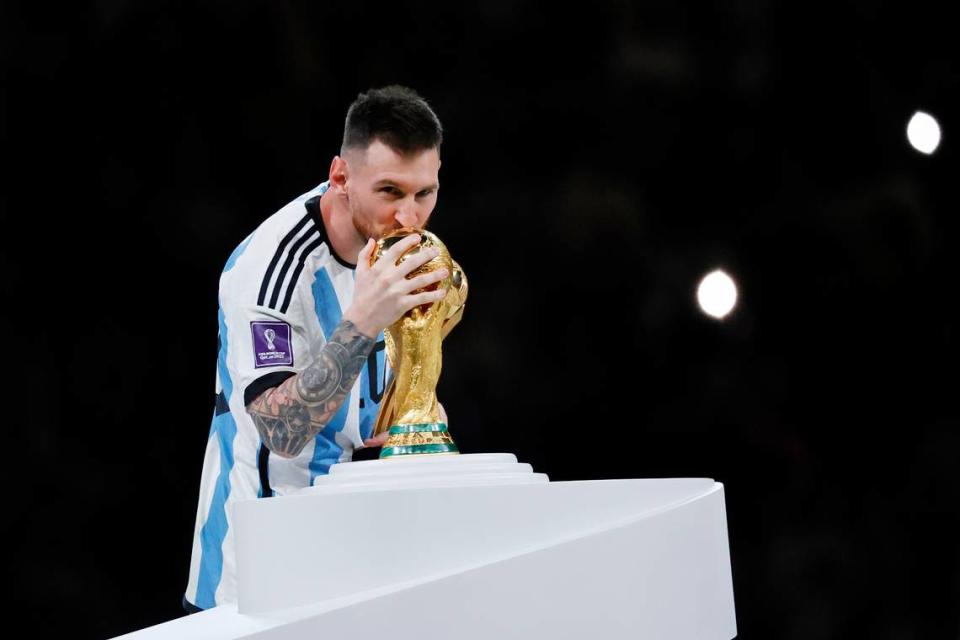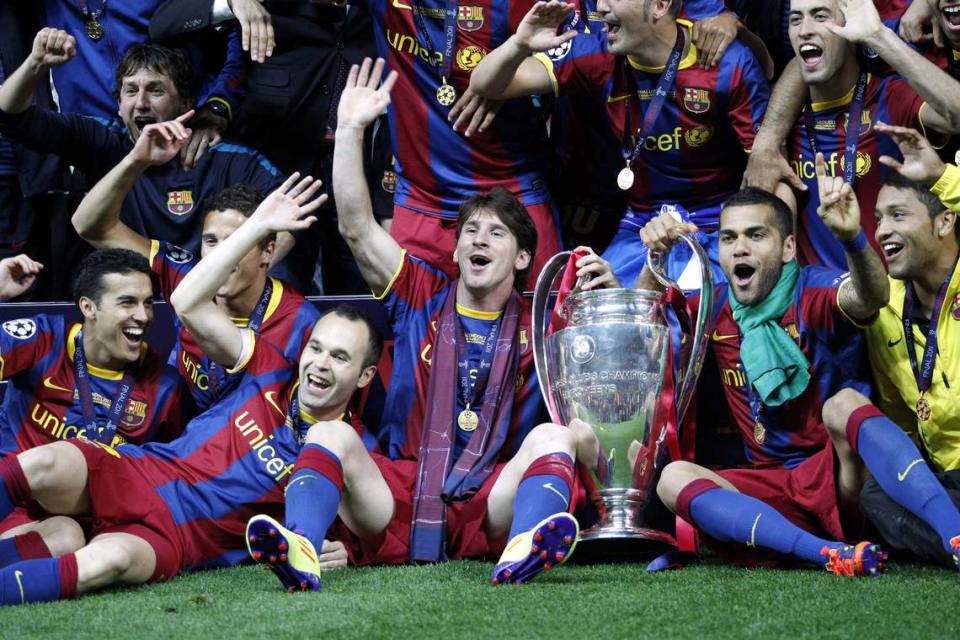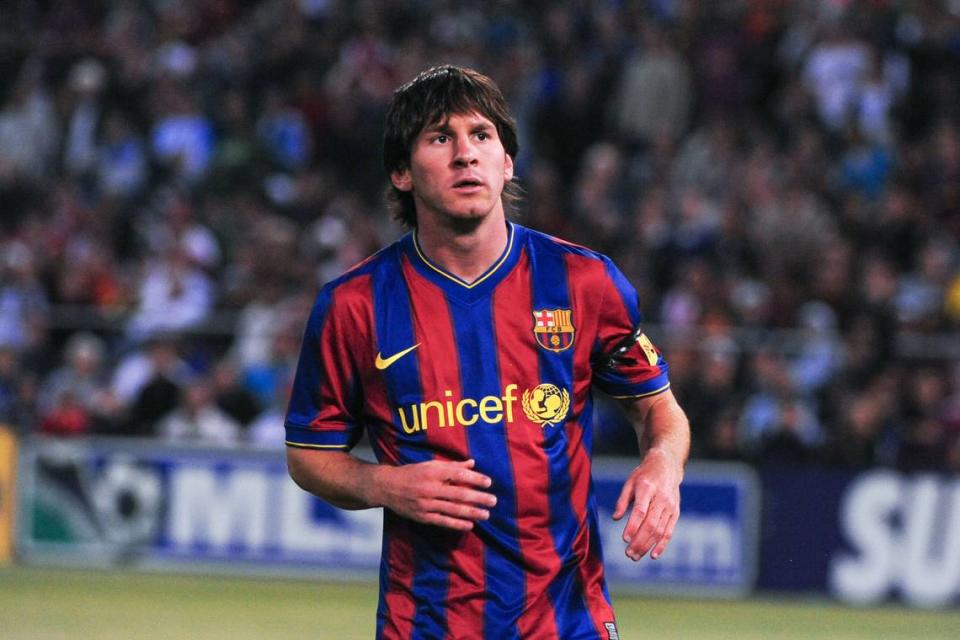How Lionel Messi went from the tiniest boy on the field to the biggest athlete in the world
- Oops!Something went wrong.Please try again later.
Long before Lionel Messi was a larger-than-life soccer icon with 468 million Instagram followers, before he became one of the world’s richest athletes and immortalized on giant murals from Buenos Aires to Barcelona to Calcutta to Miami, he was the tiniest boy on the field at Grandoli, the neighborhood soccer club in his hometown of Rosario, Argentina.
Were it not for his doting grandmother shaming a coach into putting the diminutive kid in a game and FC Barcelona offering to pay for his $900-a-month growth hormone treatments, Messi would likely not be a World Cup champion. He would not have won a record seven Ballon d’Or World Player of the Year trophies.
Nor would he have landed in South Florida this week to embark on the most unexpected chapter of his career. Messi shocked the world on June 7 when he announced he was rejecting a $500 million deal from Saudi Arabia and a sentimental pull to return to FC Barcelona, where he spent the first 21 years of his career, to join Inter Miami of Major League Soccer.
So, how did that scrawny kid from the working-class “La Bajada” neighborhood wind up in Miami as the world’s most famous athlete?
The great-great grandson of Italian and Spanish immigrants, Messi was born June 24, 1987, in the river port city of Rosario, 186 miles northwest of Buenos Aires.
Rosario also happens to be the birthplace of Che Guevara and the Argentine flag. The sky blue and white flag, which is the inspiration for the Argentine national team soccer jersey, was first raised at the city of Rosario on Feb. 27, 1812, during the Argentine War of Independence. To commemorate that historic day, the National Flag Memorial was built there.
Messi was the third of four children born to father, Jorge, a supervisor at a large mining and metal company, and mother, Celia Cuccittini, who worked at a magnet manufacturer. His father has managed his career since his pre-teen years. He has two older brothers, Rodrigo and Matias, and a younger sister, Maria Sol.
Messi, 36 and a married father of three young sons, recalled in an interview with Diario Ole his earliest days in Rosario and how they shaped his journey.
“When I was 4, I started playing at a club, and on a street, all the time,” he said. “One of my brothers or cousins was playing and the ‘86 team, a year older than me, was playing and they needed a player — so my grandmother told the coach ‘Put him [Leo] in the team.’ The coach replied: ‘No, how am I going to put him in the team, look how small he is, you’re crazy, he’s going to get hurt.’ But she kept saying ‘put him, put him.’
“Apparently when I went, I did some things and from then, my grandmother came back and told the coach: ‘Buy him football boots and I’ll take him to training next week.’ And that’s when I started.”
He became an instant phenom, joined Rosario-based club Newell’s Old Boys at the age of 6 and stayed with that team until 2000. Messi scored 234 goals in 176 matches at the youth level for Newell’s, a club that still holds a special place in his heart and the club where new Inter Miami coach Tata Martino also got his start.
Messi’s grandmother, Celia Olivera Cuccittini, died when Leo was 10 years old and never got to see him play professionally or lift the sport’s biggest trophies. But to this day, almost every time he scores a goal, Messi looks up and raises his hands to the sky in memory of his beloved “Abu.”
Messi’s dazzling ball skills and field vision were evident from a young age; however, he remained undersized.
At age 11, he was diagnosed with growth hormone deficiency. His subsequent treatments have been well-documented. The treatments, estimated to cost $900 a month at the time, included daily injections into his legs that help patients not only grow but deal with other medical conditions that often are related to GHD.
His parents could not afford to continue the treatments for an extended period, but when Messi was 13, he was invited to try out for FC Barcelona’s famed La Masia youth academy, and the Spanish club was so interested in him they offered to cover the costs of the remaining hormone treatments. As legend has it, young Messi signed his first contract on a restaurant napkin after Barcelona’s sporting director Carles Rexach made the offer.
Messi becomes the atomic flea
Three years later, Messi made his Barcelona debut at age 16 in a friendly against a Porto team coached by the legendary Jose Mourinho. He would spend the next two decades at Barcelona breaking every conceivable record. At 5-7, he has a low center of gravity and is extremely agile, which helps him evade defenders. His Spanish nickname is “La Pulga Atomica” (the atomic flea).
On Dec. 23, 2020, he surpassed Brazilian legend Pele with his 643rd goal for Barcelona, the most ever scored for the same club. His 50 goals in the 2011-12 season were the most ever by a Barcelona player. He had 36 hat tricks, won three Champions League titles with Barca and scored 120 Champions League goals.
One of Messi’s greatest admirers is renowned Fort Lauderdale-based TV commentator Ray Hudson, a retired English player who played for the Fort Lauderdale Strikers, coached the Miami Fusion and spent the past two decades trying to put Messi’s genius into words. He is known for his hyperbole, especially where Messi is concerned. A few of his Messi goal calls are featured in the FC Barcelona Museum at Camp Nou stadium.
Among the best known:
“Centipedes fantasize about having one left leg as good as his.”
“Genius. That’s beyond bull’s-eye! His dart splits the darts. Astonishing Messi. You could drop a tarantula down his shorts and he’d still be super cool.”
“Defenders try to follow him on Facebook, and he comes out on Twitter. That’s how evasive he is.”
His most popular word to describe Messi is magisterial, pronounced more like “Magisteeeeeerial!”
“Magisterial Argentinian. Magisterial Leo. Running like he’s got a food mixer down his shorts, and it’s set to beat.”
What makes Messi special?
Hudson says announcing Messi’s games has been one of the greatest thrills of his life, and one of the most challenging because it is difficult to explain what makes the Argentine so special.
“Pele wasn’t very big, Diego Maradona wasn’t very big, it seems God likes little players that could,” Hudson said. “God doesn’t really go for 6-foot, 7-foot soccer players. Messi’s whole life, the development of him from the precocious youngster, the gift was so evident then. There’s been encyclopedia-sized stories written about how the world recognized that this was something special. They saw it in Pele. They saw it in Maradona.
“What I believe is that it’s the fourth dimension, a different vision in their minds that they see the game through. All footballers see the game in a herky-jerky type of movement. But there’s a special breed of players, the likes of [Johan] Cruyff, [Franz] Beckenbauer, Pele, Maradona and Messi, only a handful that are operating on a different frequency than their teammates. They can almost slow the game down in their own mind, even though the chaos is flying around everywhere around them.”
Fernando Fiore, the longtime Miami-based Argentine soccer announcer has been following Messi since his teen years with Barcelona’s youth team. Like Hudson, Fiore is an excitable man of many words, but he struggles to find the perfect description of Messi.
“I saw him live a million times, training sessions with the World Cups, etcetera, and what we always say in Argentina is that it looks like he has the ball tied to his foot because he is always running fast with the ball very close to his boot,” Fiore said. “It’s very difficult to try to get the ball from him without provoking a foul.”
Also, Fiore said, Messi is faster than people may think, even in his mid-30s. He saw it up close from the sideline at World Cup games in Qatar this past December, as Messi led Argentina to the world championship, the only trophy that had been missing from his resume.

“Many people were thinking, ‘Oh, man, this World Cup, he’s going to be slower, he’s not the same fast-paced player he was before,’ but he shocked me,” Fiore said. “Argentina against Croatia, there was a young kid [Josko Gvardiol] who was being a star in the World Cup, everybody was talking about. And then Messi just blew him away on the sideline, and I was right there. I saw him passing by like a flash. He’s a 36-year-old guy, and he still can do that.”
Messi’s former Barcelona coach Pep Guardiola once said: “Messi is the only player that runs faster with the ball than he does without it.”
His soccer supremacy, longevity and clean-cut image have made him the highest-paid athlete in the world in recent years, but he slipped to No. 2 on the Forbes list of highest-paid athletes in 2023 (just behind Cristiano Ronaldo) at $130 million — $65 million on the field, $65 million off. Messi’s net worth is estimated at $600 million.

An impressive portfolio of sponsors
Among his portfolio of sponsors: Pepsi, MasterCard, Budweiser, Gatorade, Hard Rock International (which named a chicken sandwich after him this week), Louis Vuitton, the Saudi Arabia Tourism Bureau and Adidas, with whom he signed a lifetime deal in 2017 estimated at $1 billion.
Adidas also happens to be a major MLS sponsor, which is believed to be one of the many reasons Messi chose to move to the United States and continue his career with Inter Miami after spending the past two seasons at Paris Saint-Germain. According to sources familiar with the negotiations, Messi will get a cut of all No. 10 Inter Miami replica jerseys sold, and that shirt is projected to be among the top-selling shirts of all time. Maybe the top selling of all time.
Factories in Vietnam, Norway, Italy and Miamisburg, Ohio, (yes, Miamisburg) have been bracing for the onslaught of orders for weeks, as the Avery Dennison company added Messi’s name and number to all the Adidas inventory of black-and-pink Inter Miami shirts it could get its hands on.
Messi is also said to be signing a deal with Apple, which owns the broadcast rights for MLS and aims to expand the league’s reach around the world with its MLS Season Pass streaming service.
His actual salary will be paid by Inter Miami. He was offered a two-and-a-half-year contract with an option for 2026, as well as equity in the team when his playing days are over. The total package is valued at $130 million to $150 million.
Copa America, the most prestigious South American tournament, will be held in the United States in the summer of 2024. The 2026 World Cup will be co-hosted by the United States, Mexico and Canada, with several games to be held in Miami. Establishing business relationships on American soil makes economic sense for Messi at this stage of his career.
Although Messi certainly has financial reasons for coming to America, he also made the decision for personal lifestyle reasons. Messi, his parents, and his wife, Antonella Roccuzzo, whom he married in 2017 after a decade together, love Miami, its beaches and its Latin flavor.
They have been vacationing in Miami Beach for years and own two luxury, waterfront condos in Sunny Isles Beach. One is at the Porsche Design Tower and the other at the Regalia Tower. It is unclear if they plan to live there, as they are said to be house hunting. They rented a house in Key Biscayne during their last family vacation.
Miami loves Messi back, as evidenced by the murals of the soccer star that popped up in Wynwood and downtown Miami during the past month.
Messi is hoping his family can lead a more normal lifestyle in South Florida than it did in Spain, France and Argentina, although their first meal out in Miami Beach on Wednesday ended with fans waiting outside for selfies.
“Let’s be honest, he didn’t have a normal life in Europe,” Fiore said. “It’s not like he was going to the movies with his kids on a Sunday afternoon buying popcorn and sitting in row 13. He was living probably mostly at his home. He got everything that he wanted at his disposal. His friends, his closest friends, the other players, they don’t go on vacation to South Beach and go to the Delano hotel. They go to a private island or something that is completely secluded, so that will not change much. He won’t be able to go to have churros and a coffee at Manolo on a Monday morning.”
He’s here to help Inter Miami win
Messi arrived in Fort Lauderdale on Tuesday with his family, wearing pink shorts as he got off a private jet, but he insists that this time, he is not coming here to vacation. Inter Miami is in last place in the Eastern Conference with 13 games remaining, and Messi is determined to lead the turnaround.
“My mentality and my head will not change, and I will try, wherever I am, to give the maximum for me and for the club, in order to continue to perform at the highest level,” he said on a recorded interview this week with TV Publica, Argentina’s public television station.
“We are satisfied with the decision we have made. Prepared and eager to face this new challenge, this new change.”
Diego Valeri, a teammate of Messi’s on Argentina’s youth national teams, played eight years with the Portland Timbers and won the MLS Cup MVP after leading the Timbers to the 2015 league title. He predicts Messi will adapt quickly and benefit from the league’s attacking style.
“He said he is coming here to enjoy the day to day, to enjoy the sport, and this league will give him everything he needs as a professional so he can focus on just playing,” Valeri said. “He will feel like a young kid again. The stadiums will be fantastic, everyone will receive him with a lot of love, and I think he will feel that adoration from fans of every team in the league.”
Despite all his money and fame, Messi is known for his humility and simple pleasures. He likes to play padel, watch soccer and tennis and hang out at home with his family. His wife, Antonella, is a social media influencer (36.1 million followers) and is a brand ambassador for high-profile companies Alo Yoga and Guerlain. Their three sons are Thiago, 10; Mateo, 7; and Ciro, 5
Messi is an animal lover who has posted photos with his dog Hulk, a giant French Mastiff. He also likes to decorate his body with elaborate tattoos, something he has in common with his new boss, Inter Miami co-owner David Beckham. Messi has a portrait of his mother, Celia, on his back. A large soccer ball adorns his left lower leg. A portrait of Jesus is on his right shoulder, and a lotus flower is among the several tattoos on his arm sleeve. He also has tattoos of the birth dates of his wife and three sons.
“For being as famous as he is, he is a very humble person, is a family man, and treats all his teammates as equals, even though he is their idol,” Valeri said. “He’s very nice to be around. He was already that way when I last played with him 10 years ago, and now, I notice he is even more that way, more mature. He will be a great locker room leader for those Miami players.”
Hudson agrees and is delighted that his favorite player has chosen to play in South Florida.
“I’ve seen him charm the birds out of the trees; the crickets in the flippin’ trees love Messi,” Hudson said. “The people who haven’t seen him, who have only seen him in the television or in the great highlight reels ... it’s not drawing too much of an exaggeration to say if you had been able to watch a Shakespearean play with Shakespeare watching alongside you or listen to Beethoven’s music or watch Rembrandt paint, we can do that now. He’s here. He’s here in Fort Lauderdale, in South Florida.
“For the millions and millions of people in this country that are going to have the privilege of seeing, my opinion, arguably the greatest football player of all time. And wearing the shirt of Inter Miami has to be a great source of pride for the ownership group, to pull this off. I’m so happy for the league. I’m so happy for the club. And for the area especially football crazy South Florida. Messi knows whenever he’s ever come here he’s been absolutely swamped. The security is going to have to be really amped up in a big, big way. This incredible odyssey is gonna take place now after he has given us all so much for two lifetimes. And he comes here to put the final note. Let’s hope it’s an exclamation point.”


